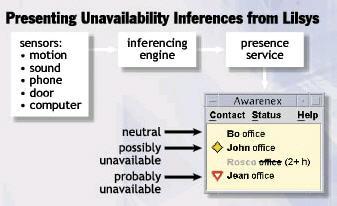Receptive Presence Awareness Equals On-Demand Availability
'Presence' awareness has rapidly become one of the most compelling features of Instant Messaging (IM) applications. Never before in the history of communications have we been able to tell whether the person we want to communicate with can actually be reached before we try to engage with them.

Image source: ACMQueue
Presence indicators allow us to decide how and when we should communicate with someone else. If we are able to be made aware that the person we want to contact is in a meeting, or out to lunch, or on the phone, or travelling from A to B, or on vacation, we can then make our own judgement call as to when and how best to reach them - by phone, voicemail, email, IM, fax, letter and so on.
However, simply knowing about someone's 'presence' doesn't tell us about their 'availability', or how 'receptive' they are to being communicated with.
Existing technologies are great for determining presence, but are sorely lacking when it comes to understanding availability or receptivity.
Availability or receptivity can be thought of as a person's willingness to be interrupted.
In a research paper presented at the Association for Computing Machinery (ACM) Conference on Computer Supported Cooperative Work, held in Chicago on November 6-10, 2004, a team from Sun Microsystems, MIT and IBM Almaden Research, presented a prototype system, called Lilsys.
"Another way to manage availability is to have a system gather clues from your environment and present an inference about your availability. Researchers at Carnegie Mellon University conducted a study to determine the most salient sensors in making an availability inference of an office worker.
Based on their results, our research group prototyped the Lilsys system, which consists of the most salient sensors identified: sound, phone usage, and computer activity.
In addition, Lilsys includes a motion sensor to detect a person's presence, a necessary condition for inferring availability. We also added a sensor to detect when the door is open or closed for staff who close their door when they do not want to be disturbed.
Lilsys synthesizes information collected from the sensors and attempts to infer when the person is not available for an interruption.
The inferencing engine makes an assessment of the person's unavailability based on the amount and type of evidence collected by the sensors. To suggest a person's inferred unavailability to a prospective caller, Lilsys uses a traffic-sign metaphor: neutral (no inference), a diamond-shaped yellow "warning" sign that indicates possibly unavailable, and a triangular, red-bordered "yield" sign to indicate the person is probably unavailable.
Availability inferencing can coexist with setting explicit status in a presence system because they have complementary tradeoffs. Whereas setting status explicitly requires user action, the sensors collect information passively. Also, explicit status is obtained only when the user remembers to set it, while the availability inference is updated as soon as a change in the user's context is sensed.
On the other hand, while an availability inference is necessarily vague, explicit status can be descriptive. Rather than presenting all of the details about a person's context, Lilsys presents an abstraction of the person's unavailability, which provides a measure of privacy by hiding the details of a person's activity. Individuals have differing tolerances for privacy/publicity trade-offs.
Because Lilsys integrates information from a variety of sensors and other sources, it demonstrates yet another type of awareness service with implications for the architecture of platform infrastructures. In this case, the raw information from each source is potentially sensitive and not necessarily salient to users, while the resulting inference is salient."
For all the hype, presence indicators within such applications as online collaboration systems, still have a long way to go before they reflect true human nature.
Just because the door to my office is open and I just happen to be staring out of the window, don't take it for granted that you can come in and interrupt me.

blog comments powered by Disqus